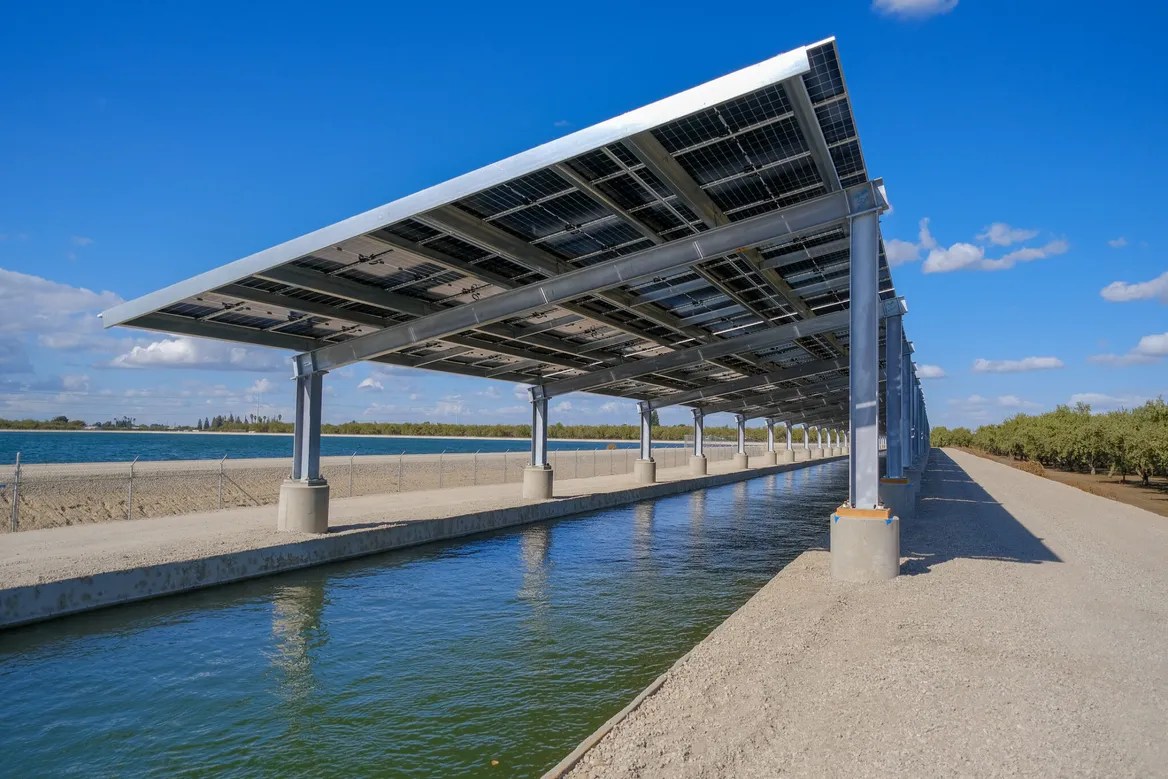This story was originally published by Canary Media and is reproduced here as part of the Climate Desk collaboration.
A novel solar power project just went online in California’s Central Valley, with panels that span across canals in the vast agricultural region.
The 1.6-megawatt installation, called Project Nexus, was fully completed late last month. The $20 million state-funded pilot has turned stretches of the Turlock Irrigation District’s canals into hubs of clean electricity generation in a remote area where cotton, tomatoes, almonds, and hundreds of other crops are grown.
Project Nexus is only the second canal-based solar array to operate in the United States—and one of just a handful in the world. America’s first solar-canal project started producing power in October 2024 for the Pima and Maricopa tribes, known together as the Gila River Indian Community, on their reservation near Phoenix, Arizona. Two more canal-top arrays are already in the works there.
In California, the solar-canal system was built in two phases, with a 20-foot-wide stretch completed in March and a roughly 110-foot-wide portion finished at the end of August. Researchers will study the project’s performance over time, while a new initiative led by California universities and the company Solar Aquagrid will push to fast-track the deployment of solar canals across the state.
Proponents of this emerging approach say it can provide overlapping benefits. Early research suggests that, along with producing power in land-constrained areas, putting solar arrays above water can help keep panels cool, in turn improving their efficiency and electricity output. Shade from the panels can also prevent water loss through evaporation in drought-prone regions and can limit algae growth in waterways.
Plus, solar canals could offer a faster path to clean energy development than utility-scale solar farms, especially in rural parts of the US where big renewables projects increasingly face community opposition. Placing solar panels atop existing infrastructure doesn’t require altering the landscape, and the relatively small installations can be plugged into nearby distribution lines, avoiding the cumbersome process of connecting to the higher-voltage wires required for bigger undertakings.

“Why disturb land that has sacred value when we could just put the solar panels over a canal and generate more efficient power?” said David DeJong, director of the Pima-Maricopa Irrigation Project, which is developing a water-delivery system for the Gila River Indian Community.
The purpose of these early arrays is primarily to power on-site canal equipment like pumps and gates. But such projects could eventually help clean up the larger grid, too. A coalition of US environmental groups previously estimated that putting panels over 8,000 miles of federally owned canals and aqueducts could generate over 25 gigawatts of renewable energy—enough to power nearly 20 million homes—and reduce water evaporation by possibly tens of billions of gallons.
Still, the technology isn’t an obvious choice for many canal operators.
Elevating solar panels over canals is more expensive and technically complex than installing conventional ground-mounted solar arrays on trackers, and it can involve using more concrete and steel. Wider canals may also require support structures for panels within the waterway, which can disrupt the flow of water.
Earlier this year, a senior engineer at Arizona’s Salt River Project recommended that the power and water utility not pursue a solar-canal pilot “based on cost estimates and project concerns,” after comparing the unique design to both rooftop and utility-scale solar alternatives.
Solar-canal developers are hoping they can still gain a toehold in irrigation districts that are grappling with high electricity costs and have limited options for generating cheap power, said Ben Lepley, the founder of engineering firm Tectonicus, which designed the Gila River Indian Community’s 1.3-MW system south of Phoenix.
The initial costs are “definitely higher…but it can actually be really fast as a project,” Lepley said. “By the next year, you can have really cheap electricity, and that gives [irrigation districts] stability over the 30-year life of the project.”
For its part, the Gila River Indian Community is building solar-canal projects as part of its broader mission to “generate enough renewable energy to completely offset the electrical use by the irrigation district,” said DeJong. He noted the district pays about $3 million a year for the 27 million kilowatt-hours of electricity it needs to pump, move, and store water.
The community built its first solar-canal project over the Casa Blanca Canal with a nearly $5.7 million grant provided by the Inflation Reduction Act—part of a $25 million provision that supplied funding for the U.S. Bureau of Reclamation to design, study, and deploy projects that put panels over waterways. Irrigation districts in California, Oregon, and Utah received the remaining funds to develop their own installations.
The Trump administration is unlikely to support future programs, given its focus on gutting clean energy incentives, but a handful of projects are already moving forward without such grants.
DeJong said that construction is 90 percent complete on the tribal community’s second solar-canal project, a nearly 0.9-MW array built in partnership with the US Army Corps of Engineers, which is slated to go online later this year. The community is self-funding a similar-sized project over the Santan Canal and is developing a floating solar array on one of its reservoirs, with both systems set to be up and running by early 2026. All told, the installations will provide 4 MW in local clean energy generation, he said.
“We have become really familiar with the economics of building these [canal] projects,” said Lepley, whose firm also worked on the Gila River Indian Community’s second and third solar-canal systems. “We have a pretty good playbook of how to continue these projects going forward, even without any grant funding from the federal government.”
This post has been syndicated from Mother Jones, where it was published under this address.
